Our numbers are growing. From an existing population of 7.7 billion people, we are steadily looking an estimate of 9 billion by the year 2050. As our numbers continue increasing, so does the demand for food and shelter. But the available land on our planet is limited. On the contrary, as the demand for shelter increases, more and more agricultural land is encroached on to produce food which either increases the pressure to increase productivity or to clear forests and other green covers to get more land for agriculture – neither of which are in the best of interests for our environment.
We have come a long way in the past few decades to meet the food demands of this huge population. But it is time to pause for a minute and think about what kind of food we are consuming. Our food today has more calories and less nutrition. Carbohydrates are our primary source of energy as it is cheap, easily available, and an instant source of energy; cereals make up more than half of the total population in the world. In addition, we consume a lot of processed and ultra-processed food, that requires minimal or no cooking and is very easy on the pocket. Meat has become more available and more accessible; as more people increase more consumption, the ecological footprint they leave behind is tremendous and is severely unsustainable.
Food Pyramid vs. Environmental Pyramid
How do we know that the food we consume is not nutritious enough for us? The FAO (Food and Agriculture Organization) describes this condition as the ‘Triple Burden of Disease’ in which there is a trend of rising in the number of underweight people as well as several obese people in the world, neither of which is nutritionally whole. A third group exists where people who seem seemingly healthy suffer from lack of micronutrients essential for the body’s metabolism – this is termed as ‘hidden hunger.’ This diet is characterized by a higher intake of animal proteins, processed and ultra-processed food, unhealthy hydrogenated fats, and very little fiber have led to increasing obesity which has, in turn, led to the increase in the incidents of deaths due to non-communicable diseases (NCDs).

We have a responsibility – to ourselves, to our fellow residents on the planet and to the planet itself. Our responsibility is to eat a nutritious diet, prevent wastage, and to eat sustainably. Little behavioral changes in what we eat and how we eat goes a long way in reducing the ecological footprint that the ingredients we use to leave behind from the point they are produced to the point they end up in waste. Researchers and academics around the world have moved from the concept of from ‘farm to fork’ to ‘farm to flush’ and it is time we see how we can do our bit. To address this global concern, FAO, in the year 2010, together with Biodiversity International accentuated the importance of “sustainable diets” which they defined as:
[⋯ ] diets with low environmental impacts which contribute to food and nutrition security and healthy life for present and future generations. Sustainable diets are protective and respectful of biodiversity and ecosystems, culturally acceptable, accessible, economically fair and affordable; nutritionally adequate, safe, and healthy; while optimizing natural and human resources. [⋯ ] 1
Sustainable diets can address the consumption of foods with lower water and carbon footprints, promote the use of food biodiversity, including traditional and local foods, with their many nutritionally rich species and varieties.
The Barilla Centre for Food and Nutrition came up with a double model termed as “The Double Food and Environmental Pyramid” which is a representation that arranges very components of food in a hierarchy based on their contribution to nutrition as well as their environmental impact. A proposed diet by American physiologist Ancel Keys showed a population that ate a balanced array of natural foods rich in olive oil (monounsaturated fat), enjoyed greater longevity. He termed this as the ‘Mediterranean Diet.’
The Double Food and Environmental Pyramid

This design, while based on a Mediterranean Diet, provides a basis for the type of consumption that can be adapted to various cuisines. The bottom and most important is fruits and vegetables. Eat the ‘colouries’ and not calories. These provide all the essential macro and micronutrients in the body. They also have the least ecological footprint. Next on the ladder are our grains, which are an essential source of energy. Plant proteins in the form of legumes are recommended next along with healthy oils with greater emphasis being on olive oil. An equivalent monounsaturated oil that the Indian diet comprises of is the mustard oil. Animal sources of food are the least recommended because of their tremendous environmental impact in comparison to the nutrition that they provide. Livestock produces 7.1 gigatons of the total 11.76 gigatons of carbon dioxide emissions from the agricultural sector.
All this research suggests to us that the type of diet we consume has a significant effect on the environment. Take a moment and imagine the potential reduction in an environmental footprint that one could achieve by just modifying eating habits. The results of the analysis of The Double Pyramid suggest to us that by far a vegan diet has the lowest environmental impact with lacto and lacto-ovo forms of vegetarianism following respectively. In cultures where it is difficult to entirely eliminate meat from the diet, limiting the consumption to two days a week can also moderately help individuals reduce their environmental impact generated by food consumption by up to one thirds.
The earth isn’t dying, but we are going to if we do not act fast enough to slow down the detrimental anthropological impact on the environment or consume diets that do us more harm than good. A sustainable diet goes a long way in increasing longevity- by reducing health risks and saving our surroundings.
1 Ruini, L. F., Ciati, R., Pratesi, C. A., Marino, M., Principato, L., & Vannuzzi, E. (2015). Working toward healthy and sustainable diets: The “Double Pyramid Model” developed by the Barilla Center for Food and Nutrition to raise awareness about the environmental and nutritional impact of foods. Frontiers in nutrition, 2, 9.









Let's discuss here - Share your thoughts and queries!